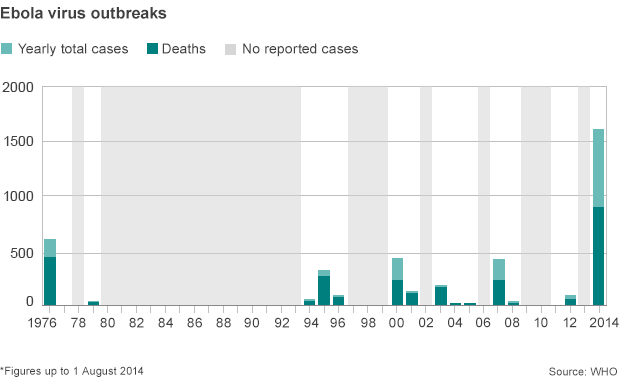
The ebola virus that has killed almost 1,000 people in West Africa this year is fatal for “up to 90%” of those infected, according to the World Health Organization (WHO). But note the words “up to”… What is the normal fatality rate, asks James Fletcher?
The WHO describes ebola as “one of the world’s most virulent diseases”. It is, according to the organisation’s website, “a severe, often fatal illness, with a case fatality rate of up to 90%”.
A case fatality rate – or CFR – is a relatively simple measurement. It’s the number of people diagnosed with an illness divided by the number of people who die because of it. But in the current outbreak, the proportion of infected people dying is far lower than 90%.
“That 90% figure actually comes from one outbreak of ebola which took place in the Congo between 2002 and 2003. It’s the highest rate we have ever seen,” says Maimuna Majumder, a biostatistician and epidemiologist at the Massachusetts Institute of Technology.
“The cumulative average considering all ebola cases and deaths from 1976 to the present is actually closer to 60-to-65% and the current outbreak has a CFR of about 54% – though it’s subject to change as the outbreak goes on.”
This figure of 54%, however, is an average taken from several countries. The fatality rate varies from one country to another – in Guinea it’s about 73%, whereas in Liberia its 55%, in Sierra Leone it’s 41% and in Nigeria it’s 11%.
Why the variation?
The main factors, according to Majumder, are the level of preparedness and the availability and quality of medical care.
Another factor – when it comes to the varying CFR from one outbreak to the next – may be the different strains of the disease. Of the five known ebola strains, the “Zaire” and “Sudan” strains have been responsible for most deaths. The Zaire strain’s average fatality rate is 79% and the Sudan strain’s is 54% – research on the current outbreak, in Guinea, suggests that it is caused by the Zaire strain.
The CFR doesn’t tell you how contagious a disease is. Ebola, transmitted through contact with bodily fluids, is much less contagious than airborne diseases such as influenza or measles. What it can do is indicate how serious the disease is, for those patients infected with it. But as we’ve seen, this varies.
“When you have large ranges of CFR like you do with ebola, it isn’t really appropriate to give one extreme or the other,” Majumder says. “I think if we were to use a CFR for ebola we really ought to give the case average since initial emergence of the disease in 1976 – and that is significantly less than the 90% estimate that we hear a lot of in the media.”
And which we also hear about on the WHO website.
Source: BBC
